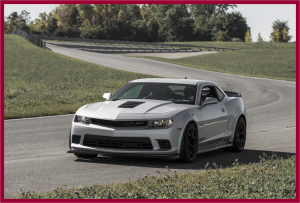
The first Z/28 introduced in 1967 was created to compete in the Sports Car Club of America’s Trans-Am 2 class.
A new 2014 Camaro Z/28 running at Germany’s Nürburgring road course posted a 7:37.40 lap time, Chevrolet says. This beats the best times for the Porsche 911 Carrera S and the Lamborghini Murcielago, among other expensive cars that cost much more than the ~$60,000 Z/28.
GM claims that the increased grip of the Z/28 is capable of 1.08 g in cornering acceleration, and the Brembo carbon-ceramic brakes provide 1.5 g in deceleration. The lower curb weight of the naturally aspirated Z/28 – 300 pounds less than the supercharged Camaro ZL1 – also helped the during the performance setting run.

The 2014 Chevrolet Camaro Z/28 team at its world debut during the 2013 New York International Auto Show.
“One of the challenges of testing at the ‘Ring is that the track is so long that conditions can change radically in a single lap,” said Al Oppenheiser, Camaro chief engineer. “Adam Dean, the development driver for Z/28, did a heroic job driving in deteriorating conditions. Based on telemetry data from our test sessions, we know the Z/28 can be as much as six seconds faster on a dry track.”
The Z/28 is powered by a 7-liter LS7 engine that was first used in the Corvette. It has lightweight components including titanium intake valves and connecting rods, aluminum cylinder heads and a forged-steel crankshaft. It is rated at an SAE-certified 505 horsepower (376 kW) and 481 lb.-ft. of torque (652 Nm). For street ac cars, air-conditioning is available, but only as an option. A close-ratio Tremac six-speed manual transmission is the only transmission and power is distributed to the rear wheels via a limited-slip differential featuring a helical gear set, rather than traditional clutch packs. The new design, Chevy maintains, allows the driver to apply more power and get through corners faster, by making the most of an individual-wheel antilock brake, which is active during corner entry, braking, mid-corner speed and corner-exiting driving.
The 2014 Camaro – the best selling sports car in the U.S. for the past three years, has a revised exterior design that tweaks aerodynamics for more efficient cooling and stability at high speeds. Chevrolet also claims that the Z/28 version has a full aerodynamics package that creates down force at higher speeds, making it the most track-capable but still street legal set-up in Camaro’s history.
The first Camaro Z/28 introduced in 1967 was created to compete in the Sports Car Club of America’s Trans-Am 2 class. It had a smaller, lighter, 302-cubic-inch V8 engine for improved balance, as well as quick-ratio steering and a heavy-duty suspension for track use. In keeping with its road-racing focus, the 1967 Camaro Z/28 was not available with an automatic transmission or air conditioning.
The new Z/28 is not designed for a specific race series, but it is on paper a competitive piece. Chevy claimed that Z/28 is three seconds faster per lap than the Camaro ZL1. A major redesign of the pony car is a couple of years off, though. This next Camaro will move production from what is now its home plant in Oshawa, Ontario since its fifth generation revival in 2009 to Lansing, Michigan. Ford is scheduled to build a heavily revised Mustang in Michigan during 2015, meaning the pony car and horsepower wars will continue for the near future.
Read AutoInformed on:

